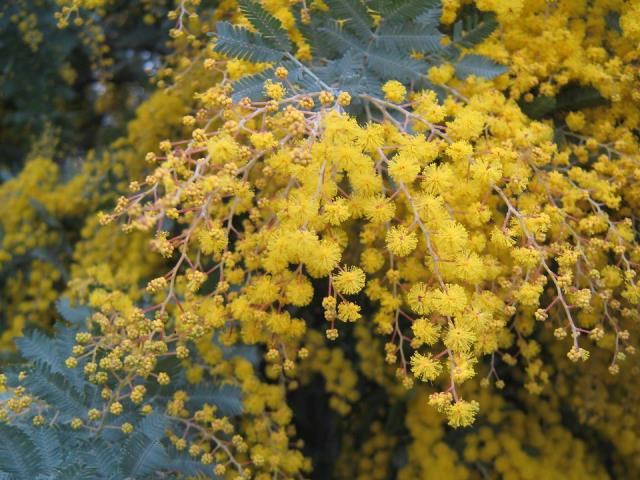By Beatrice Hawkins
When the bus started down the eastern side of Cunningham’s Gap early on Saturday morning as we were on our way to the Queensland Garden Expo in Nambour, I was in awe of the spectacular display of wattle growing on the roadside.
Then on Sunday I drove to Tamworth and was delighted by the continuing display.
Such a lovely sight in such cold winter weather reminds us that Spring can’t be far away.
Bright yellow in such profusion is a sight to behold and you can’t help but be cheered by the sight.
There are about 850-900 different species of wattle and I believe you could have one flowering every day of the year.
Once upon a time it was on my bucket list to have one flowering for each month of the year but that is no longer a possibility as I don’t have the room, but maybe I can get one for each season.
As a child there was a lovely Cootamundra wattle at the end of the road where I caught the bus to school and I used to delight each year as it came into flower.
I know they are the curse of many hay fever sufferers, but fortunately I am not affected, so have enjoyed many springtime bouquets over the years.
However wattle isn’t only known for its lovely blossom and as Australia’s national floral emblem.
It is an extremely useful tree and shrub and grown widely around the world.
In fact Australian wattle varieties are grown in 70 countries and there are over two million hectares under cultivation.
Some of the reasons wattle is cultivated commercially world wide are:
– Some species, especially the Tasmanian blackwood (acacia melanoxylon), are highly prized as furniture timber. There are large plantations of blackwood growing in temperate climates in countries such as Brazil, Chile, South Africa and New Zealand as well as in Australia. The timber is used not only for beautiful furniture but also in house construction, paper pulp, fibre board construction, cellulose for rayon, as charcoal and as fuel for village fires.
– Wattle bark from the black wattle (acacia mearnsii) is used for tanning and very large plantations are grown in Brazil, China, Vietnam, Kenya, South Africa and India. At about eight to ten years the bark is stripped from the trees in long strips and dried on racks before being cut up, steeped in boiling water and steamed with the resulting “liquor” being reduced and used mainly for tanning leather. The trees are then cut down and burnt. Australia once had a large tanning industry using wattle bark but, as with so many things of the past, this has been reduced to the extent that all our cow hides are now sent to China by the container load and I am finding it impossible to buy an Australian tanned hide as a floor mat.
– Wattle varieties are also harvested for their use as stock feed. Many animals have been kept alive during droughts on Mulga (acacia aneura) in our vast arid inland areas where it grows well. There are many fodder acacias in Australia, but Mulga is the common one known to many. Mulga timber is also used for fence posts, etc., in these regions as it is extremely tough. A good many Australian souvenirs made from this timber would also be found in homes across the world as it is a very eye catching and decorative with its dark rough bark, a golden layer next and deep brown heart wood.
– Wattle seed has long be known by indigenous Australians as a food source. Wattle seed is a good source of protein, fat and carbohydrate. Some varieties though, are poisonous, so more research is needed and it is not recommended that the inexperienced eat wattle seeds without knowing exactly what they are. Georgina Gidgee (acacia georginae) is one of the poisonous ones.
– In Europe wattle is known as mimosa and is grown for the cut flower trade where the bright yellow flowers are highly prized. Unfortunately, as with many European imports to Australia, some of the Australian imports have become environmental weeds over there. In Southern France 2 particular varieties, acacia dealbata and acacia farmensiana, are grown for the perfume and fragrant oil trade.
– Wattle is also grown world wide as a decorative plant. They are a very useful “pioneer plant” in that, as they are generally not long-lived, they provide protection allowing other species to become established. This has been used to great effect in a tree line at the CISRO research station near Uralla in NSW as can be seen when travelling the New England Highway. They are also used extensively in landscaping as they are very hardy and adapted to a wide range of soil and climate types.
– Wattles also have an increasing use in medicine. While their benefits have long been known to indigenous medicine, science is only recently acknowledging and researching their benefits. The tannin-rich inner bark and gum can be used for many ailments.
– Sap from the leaves of the Hawaiian “acacia koa” can inhibit golden staph bacteria and in recent times research is showing promise that the leaves of “acacia victoria” in Australia can produce chemicals capable of inhibiting tumour growth.
Researching wattle to write this article has given me a whole new appreciation of our national flower, the golden wattle (acacia pycnantha) and its many relatives.
Don’t forget the Garden Extravaganza in St Mary’s Hall in Wood Street on 26-27 July during “Jumpers and Jazz”.
Next week there will be a chance to win some entry passes that will include Devonshire tea. Watch this space!!!
*This is an old article that has been digitised so our readers have access to our full catalogue.







